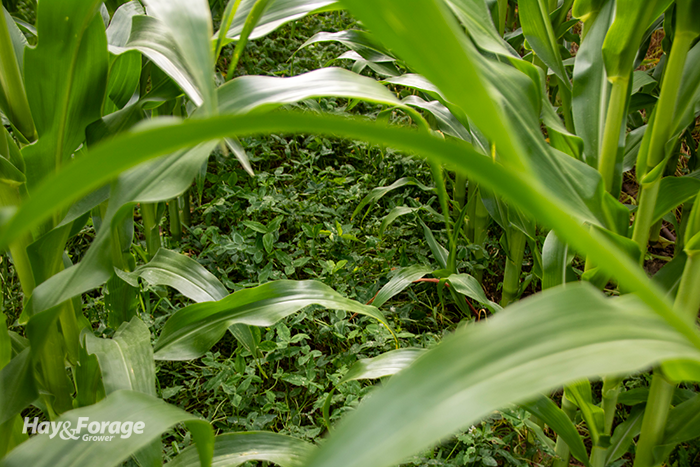
The first production year for spring-seeded alfalfa typically gets off to a slow start. In some cases, farmers may only get half of the forage yield they would expect from an established stand.
This yield drag not only impacts forage availability, but it can also pull on farm profitability, especially for dairies growing their own feed. John Grabber with the U.S. Dairy Forage Research Center (DFRC) in Madison, Wis., has set out to minimize these setbacks by exploring intercropping alfalfa and corn silage.
Over the years, Grabber has analyzed this type of system from various angles to determine how to optimize alfalfa production and corn silage yield. The main objective of a recent two-year study focused on the latter species to determine if there are certain corn hybrids that are better suited to being grown with alfalfa, which he presented in a recent DFRC webinar.
In May 2021 and May 2022, researchers interseeded alfalfa into corn immediately after planting. The same hybrids were also planted in solo-seeded plots for comparison. Plants in the alfalfa-corn system were treated with a fungicide in late June to prevent disease, which Grabber noted has been a recurring issue with his intercrop research.
Throughout the growing seasons, researchers monitored soil moisture, corn height, chlorophyll and nitrogen content, and light interception of corn. They also dug up corn plants and characterized several root traits. Then, they chopped corn for silage in mid-September of both years, measuring silage dry matter content, yield, and nitrogen content.
The researchers narrowed their scope down to 10 corn hybrids, which all demonstrated lower yields in the intercrop system. They further divided these hybrids into two groups: those with a small yield depression or a large yield depression compared to their counterparts in the solo-seeded system.
Dry weather woes
In addition to small and large yield depressions, Grabber noted corn in the intercrop system demonstrated reduced canopy growth and lower light absorption at the R1 stage. Corn chlorophyll levels, which are highly correlated to plant nitrogen content, were also lower for plants in this treatment. All of these effects were amplified in 2022, which Grabber purports was due to drier growing conditions.
After analyzing plant roots, the researchers found the solo-seeded corn had deeper roots compared to corn in the intercrop system. This was more apparent in 2022, although researchers would have expected plant roots to extend deeper into the soil profile when water resources were scarce.
The number of root tips was also less for corn in the intercrop system, especially in 2022, which would have reduced water and nutrient uptake from the soil. Grabber concluded that corn roots did not appear to be as flexible or adaptive in the intercrop system compared to the solo-seeded one.
Genetic potential
With this data, researchers used an elastic net regression to determine the characteristics of a corn hybrid that would be best suited for an intercrop system. Those include early plant maturity, high kernel abundance and starch deposition, high chlorophyll levels, good canopy development, and a deep rooting profile. In other words, the best hybrids would withstand the negative effects of being grown with alfalfa that were demonstrated in the study.
“This gives us hope that we can identify or breed corn hybrids that are better adapted to the intercropping system,” Grabber affirmed. He noted that scientists in Africa are doing more extensive intercrop research, which may expedite the identification and/or breeding processes.
With that said, Grabber’s overall goal is to optimize alfalfa production by finding ways to overcome low forage yields that most spring-seeded stands experience during the establishment year. In this type of system, corn is essentially the companion crop for new alfalfa seedings, providing additional silage that could set dairy farmers up for a better economic outcome.

